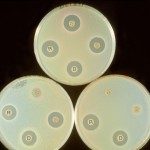Lien vers Pubmed [PMID] – 25188450
PLoS ONE 2014;9(9):e106340
Whereas fluoroquinolone resistance mainly results from target modifications in gram-positive bacteria, it is primarily due to active efflux in Listeria monocytogenes. The aim of this study was to dissect a novel molecular mechanism of fluoroquinolone resistance in this important human pathogen. Isogenic L. monocytogenes clinical isolates BM4715 and BM4716, respectively susceptible and resistant to fluoroquinolones, were studied. MICs of norfloxacin and ciprofloxacin were determined in the presence or in the absence of reserpine (10 mg/L). Strain BM4715 was susceptible to norfloxacin (MIC, 4 mg/L) and ciprofloxacin (MIC, 0.5 mg/L) whereas BM4716 was highly resistant to both drugs (MICs 128 and 32 mg/L, respectively). Reserpine was responsible for a 16-fold decrease in both norfloxacin and ciprofloxacin MICs against BM4716 suggesting efflux associated resistance. Whole-genome sequencing of the strains followed by comparative genomic analysis revealed a single point mutation in the gene for a transcriptional regulator, designated fepR (for fluoroquinolone efflux protein regulator) belonging to the TetR family. The frame-shift mutation was responsible for the introduction of a premature stop codon resulting in an inactive truncated protein. Just downstream from fepR, the structural gene for an efflux pump of the MATE family (named FepA) was identified. Gene expression was quantified by qRT-PCR and demonstrated that fepA expression was more than 64-fold higher in BM4716 than in BM4715. The clean deletion of the fepR gene from BM4715 was responsible for an overexpression of fepA with resistance to norfloxacin and ciprofloxacin, confirming the role of FepR as a local repressor of fepA. In conclusion, we demonstrated that overexpression of the new MATE efflux pump FepA is responsible for fluoroquinolone resistance in L. monocytogenes and secondary to inactivation of the FepR repressor.

